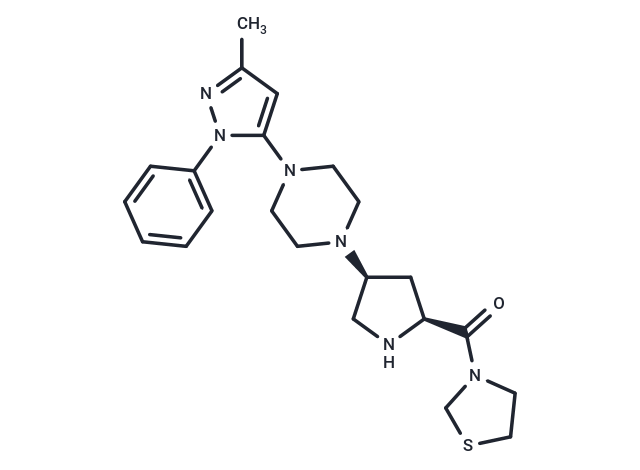Shopping Cart
- Remove All
 Your shopping cart is currently empty
Your shopping cart is currently empty

Teneligliptin (MP-513) is a novel dipeptidyl peptidase 4 (DPP IV) inhibitor for the treatment of type 2 diabetes mellitus with hypoglycemic activity for the study of obesity and diabetes.

| Pack Size | Price | Availability | Quantity |
|---|---|---|---|
| 1 mg | Inquiry | In Stock | |
| 5 mg | $30 | In Stock | |
| 10 mg | $44 | In Stock | |
| 25 mg | $68 | In Stock | |
| 50 mg | $98 | In Stock | |
| 100 mg | $183 | In Stock | |
| 200 mg | Inquiry | In Stock | |
| 1 mL x 10 mM (in DMSO) | $43 | In Stock |
| Description | Teneligliptin (MP-513) is a novel dipeptidyl peptidase 4 (DPP IV) inhibitor for the treatment of type 2 diabetes mellitus with hypoglycemic activity for the study of obesity and diabetes. |
| Targets&IC50 | DPP4 (rat plasma):1.35 nM, GLP-1(7-36) amide:2.92 nM, DPP4 (human recombinant):0.406 nM (Ki), DPP4 (human recombinant):24 μM (Km), DPP4 (human recombinant):0.889 nM, DPP4 (human recombinant):6.06 nmol/min (Vmax), DPP4 (human plasma):1.75 nM |
| In vitro | Teneligliptin inhibits DPP-4 enzyme in a concentration-dependent manner. The IC50 values of Teneligliptin on human recombinant DPP4 (rhDPP-4), human plasma and rat plasma were 0.889 nM, 1.75 nM and 1.35 nM, respectively. The kinetics of enzyme inhibition by Teneligliptin was investigated using Gly-Pro-MCA as the substrate and rhDPP-4 as the enzyme source, and the Ki, Km and Vmax values were 0.406 nM, 24 μM and 6.06 nmol/min, respectively. Teneligliptin inhibited the degradation of GLP-1(7-36)amide with an IC50 value of 2.92 nM. [1] |
| In vivo | In Wistar rats, oral administration of Teneligliptin effectively inhibited plasma DPP-4 with an ED50 value of 0.41 mg/kg, and the inhibitory effect was sustained up to 24 hours after administration. Teneligliptin at a dose of 1 mg/kg significantly reduced triglyceride and free fatty acid fluctuations in an oral fat loading assay in Zucker rats. Zucker rats receiving Teneligliptin orally for two consecutive weeks demonstrated a reduction in blood glucose fluctuations in an oral glycemic load test, as well as a reduction in plasma triglyceride and free fatty acid levels in the non-fasting state. [1] In addition, Teneligliptin improved hepatic histopathological features and reduced intrahepatic triglyceride levels in a mouse model of nonalcoholic fatty liver disease, which was associated with downregulation of hepatic lipid synthesis-related genes induced by AMPK activation. [2] |
| Kinase Assay | DPP-4 inhibition assay is carried out using either 5 ng purified recombinant human DPP-4 (rhDPP-4), human plasma (20-fold diluted with assay buffer; phosphate-buffered saline (PBS) containing 0.003% Brij-35 solution), or rat plasma (10-fold diluted with assay buffer) Gly-Pro-MCA as a chromogenic substrate as described previously with slight modifications. DPP-4 inhibitors (Teneligliptin, Sitagliptin, and Vildagliptin) are diluted with assay buffer at several concentrations. Twenty microliters of inhibitor solution, 20 μL of the enzyme source, and 20 μL of Gly-Pro-MCA (final concentration, 25 μM) are mixed with 140 μL or 160 μL of assay buffer to initiate the enzyme reaction. After 20 min (rhDPP-4) or 1 h (plasma) at 37°C, the fluorescence intensity of 7-amino-4-methyl-coumarin (AMC) generated from Gly-Pro-MCA is measured using an automated microplate reader at 360 nm excitation and 465 nm emission. The fluorescence intensity of AMC corresponded to DPP-4 activity[1]. |
| Alias | MP-513, MP513 |
| Molecular Weight | 426.58 |
| Formula | C22H30N6OS |
| Cas No. | 760937-92-6 |
| Smiles | CC=1C=C(N(N1)C2=CC=CC=C2)N3CCN(CC3)[C@H]4C[C@@H](C(=O)N5CCSC5)NC4 |
| Storage | store at low temperature,keep away from moisture | Powder: -20°C for 3 years | In solvent: -80°C for 1 year | Shipping with blue ice. | |||||||||||||||||||||||||
| Solubility Information | DMSO: 20 mg/mL (46.88 mM), Sonication is recommended. | |||||||||||||||||||||||||
Solution Preparation Table | ||||||||||||||||||||||||||
DMSO
| ||||||||||||||||||||||||||

Copyright © 2015-2025 TargetMol Chemicals Inc. All Rights Reserved.